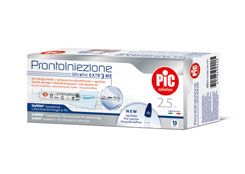
Intramuscular injections in 10 steps
Do you want to know more about intramuscular injections? We'll go through the A to Z of administering an intramuscular injection with a disposable syringe, from the necessary equipment to massaging the injection site afterwards.
1- Have everything necessary to hand
Here's everything that's needed for an intramuscular injection: disinfectant, cotton wool ball or disinfectant wipe, a sterile disposable syringe... and finally, the drug for injecting.
2 – Load the disposable syringe
When loading a sterile disposable syringe with the drug for injecting, it will normally need a few little taps to get rid of any air bubbles, which are then eliminated by squirting a few drops upwards into the air.
3 – Disinfect the injection site
To prepare the area where the intramuscular injection is going to be done, clean it with a disinfectant wipe. The buttocks are a suitable spot and usually the preferred zone is some distance away from the sciatic nerve and blood vessels.
4 – Where is the right place for the injection?
To choose the right place to do the injection, the area has to be thought of as a square, then divided into 4 smaller squares. The area in the top outer quadrant is the right spot.
5 – Time to get jabbing!
When everything's ready, the needle is inserted perpendicular to the skin with a decisive action, but not too hard. This is the right technique for minimizing any pain when administering an intramuscular injection.
7 – …Already done? Time to take out the needle!
When the drug has been administered, the needle should be removed quickly and a little pressure applied on the entry spot to stop it bleeding.
8 – The truth about massaging the site after the injection
Doing a massage of the site after an injection can cause the drug to back up through the subcutaneous tissue, so any type of massage is to be avoided with intramuscular injections.
9 – The dilemma of getting rid of the waste
When the needle has been taken out, the injection is done and it's time to get rid of the disposable syringe. However, syringes mustn't be thrown away into recycling bins, in bags of dry waste, in waste bins in public places, in containers of out-of-date drugs or in plastic or glass bottles. Syringes must be deposited in special containers made of strong plastic. Normally all this information can be found on the back of the package.
9 – The dilemma of getting rid of the waste
When the needle has been taken out, the injection is done and it's time to get rid of the disposable syringe. However, syringes mustn't be thrown away into recycling bins, in bags of dry waste, in waste bins in public places, in containers of out-of-date drugs or in plastic or glass bottles. Syringes must be deposited in special containers made of strong plastic. Normally all this information can be found on the back of the package.
10 – Injuries within 48 hours
Swelling and abscesses could develop 24 - 48 hours after the intramuscular injection has been given. If they do, a doctor's advice is needed.











